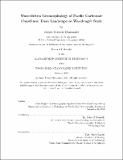Wave-driven geomorphology of Pacific carbonate coastlines : from landscape to wavelength scale
Author(s)
Bramante, James Francis.
Download1199132612-MIT.pdf (8.174Mb)
Other Contributors
Joint Program in Oceanography/Applied Ocean Science and Engineering.
Massachusetts Institute of Technology. Department of Earth, Atmospheric, and Planetary Sciences.
Woods Hole Oceanographic Institution.
Advisor
Jeffrey P. Donnelly.
Terms of use
Metadata
Show full item recordAbstract
The shallow marine ecosystems of coral atolls and the human communities they support are among the most vulnerable to anthropogenic climate change. Sea-level rise threatens to inundate low-lying reef islands, tropical cyclone intensification threatens islands with flooding and erosion, and ocean warming and acidification threaten the health of coral reefs. Unfortunately, the sediment dynamics that shape the morphology of coral reefs and atoll reef islands are poorly understood, hindering predictions of coral atoll responses to climate change forcing. Here, I apply an eclectic set of methods, including numerical modeling, physical lab experiments, and sedimentological analysis, to produce insights into the ways tropical cyclones and waves move sediment on fringing reefs. First, I use a numerical model of hydrodynamics to predict the influence of sea-level rise and wave climate change on sediment transport across a coral atoll fringing reef. I demonstrate that by the end of the century, sea-level rise will reduce sediment transport rates from the fore reef to the beach, but increase transport rates from the reef flat to the beach. Wave climate change will have relatively negligible influence on cross-reef sediment transport. Additionally, I use the weathering of foraminifera tests to produce a sediment proxy of transport duration and direction across atoll reef flats, but demonstrate that the proxy does not clearly identify storm deposits. Second, I execute a series of experiments in an oscillating flow tunnel to constrain the rate at which sediment erodes reef surfaces under waves. I find that the erosion rate increases as a power law of wave orbital velocity, and that amount of sediment has a second-order influence. Finally, I establish grain size in a sediment core retrieved from a blue hole in the Marshall Islands as a proxy for tropical cyclone genesis and, using the results from an ensemble of climate models, demonstrate that enhanced tropical cyclogenesis during the Little Ice Age may have been driven by an anomalously negative Pacific Meridional Mode. This thesis demonstrates the importance of sediment dynamics on the morphology of fringing reefs and atoll reef islands and the sensitivity of those dynamics to centennial climate variability.
Description
This electronic version was submitted by the student author. The certified thesis is available in the Institute Archives and Special Collections. Thesis: Ph. D., Joint Program in Oceanography/Applied Ocean Science and Engineering (Massachusetts Institute of Technology, Department of Earth, Atmospheric, and Planetary Sciences; and the Woods Hole Oceanographic Institution), 2020 Cataloged from student-submitted PDF of thesis. Includes bibliographical references (pages 171-186).
Date issued
2020Department
Joint Program in Oceanography/Applied Ocean Science and Engineering; Massachusetts Institute of Technology. Department of Earth, Atmospheric, and Planetary Sciences; Woods Hole Oceanographic InstitutionPublisher
Massachusetts Institute of Technology
Keywords
Joint Program in Oceanography/Applied Ocean Science and Engineering., Earth, Atmospheric, and Planetary Sciences., Woods Hole Oceanographic Institution.